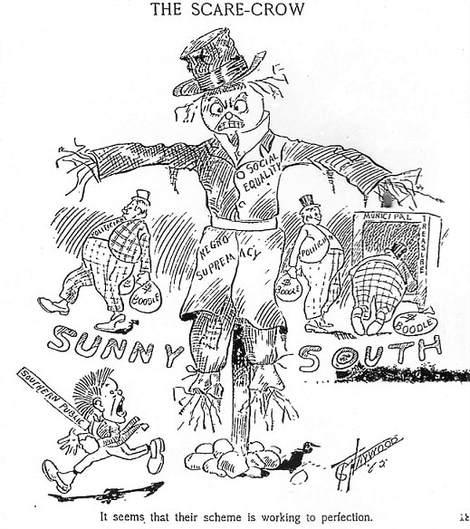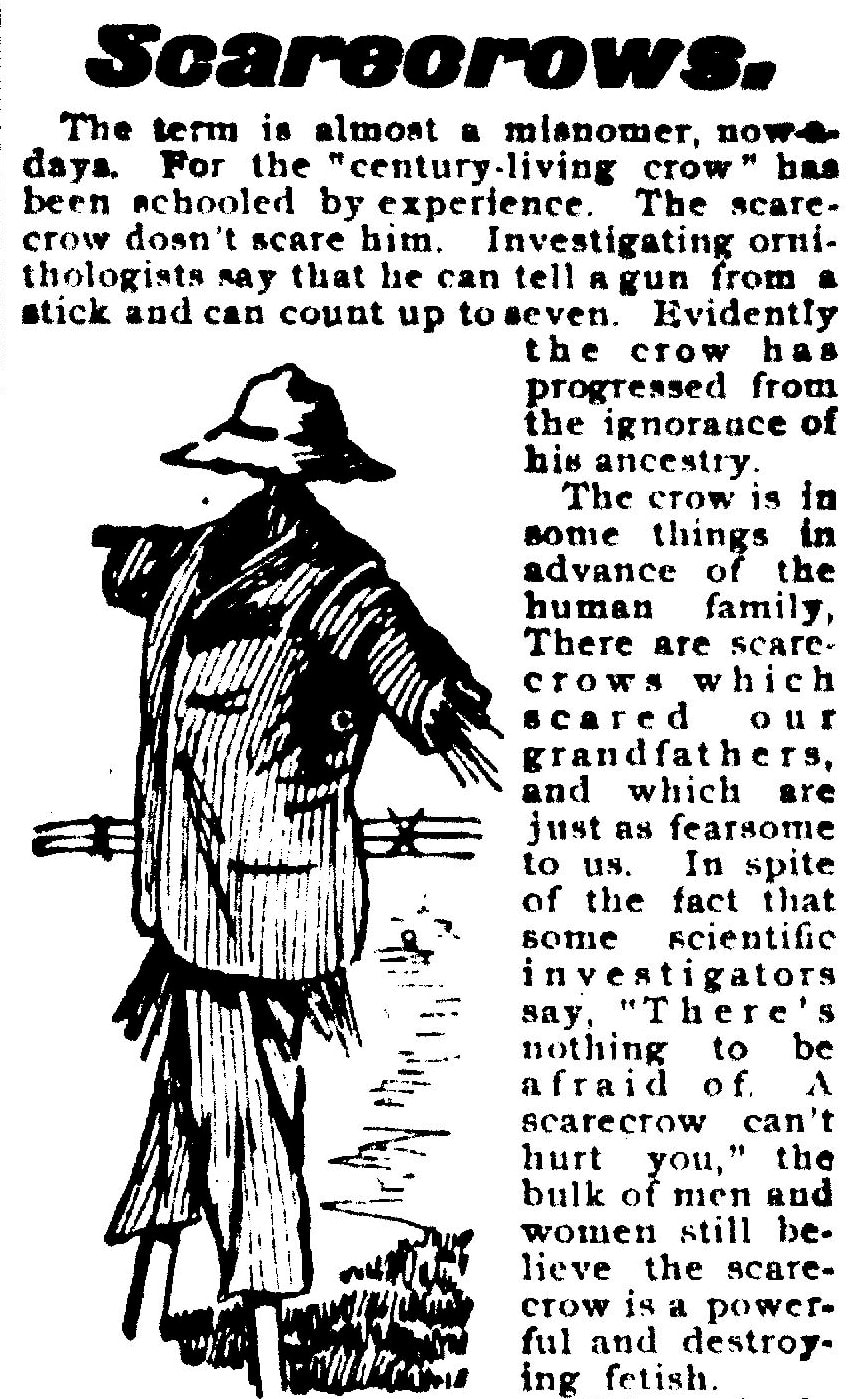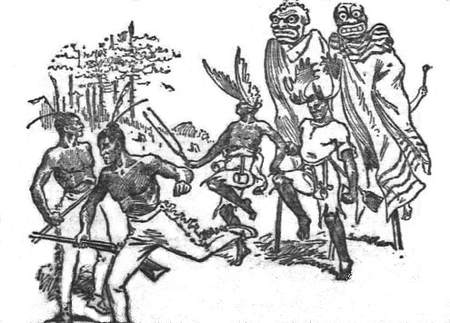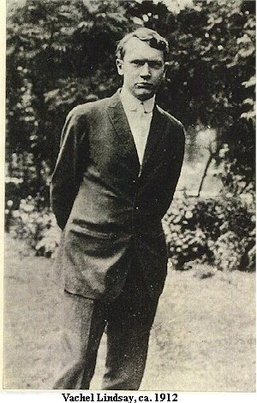|
When first listening to the Houston original cast recording of Treemonisha and then again when attending the 2000 Opera Theatre of Saint Louis production, I found the rescue scene particularly funny. Listeners and audience members hear Remus explain his plan for rescuing Treemonisha from the conjurors. I’ll wear this ugly scarecrow Back in the forest as Simon counts to three before shoving Treemonisha into the wasp nest, Remus’ approach interrupts the count. Dramatic irony creates comedy when the conjurors fail to recognize Remus, whom they could surely overpower. Seeing the “strange form” approach,“ Cephus cries out, “Look! What’s that comin’ yonder?” Panic ensues as the conjurors perhaps believe they face retribution for kidnapping Treemonisha: SIMON Remus has successfully turned the tables on the unknowing conjurors, who prey on others’ superstitions but fall victim to their own. With this scene, we easily see Joplin accomplish two goals: showing the conjurors as charlatans and simultaneously injecting humor. Once more, Joplin’s contemporaries may have seen more. Although today's audience may laugh at the naiveté of fearing a straw man set out to frighten birds, a closer look at scarecrows and the African figures resembling them may explain the conjurors' desperation. Figurative Scarecrows as Scare Tactics We needn’t look hard to discover that scarecrows were not intended solely to fright birds, but also to frighten ignorant humans. However, an historic newspaper search for the word scarecrow leads to relevant hits on figurative, rather than literal, scarecrows. Frequently, Jim Crow Southern Democrats used so-called “scarecrows,” which today we would call scare tactics, to persuade voters to support anti-civil rights legislation. For example, roughly two years after the Civil War ended, the Fort Scott (KS) Weekly Monitor commented, “During the past three years the Democracy have been engaged in manufacturing a terrible scarecrow, with which they hope to frighten Republicans into their ranks. They have now got it completed, and stood it up in the by-ways, dressed up in most hideous shape. Its name is ‘negro suffrage’” (Oct. 16, 1867). Nearly forty years later, following Theodore Roosevelt’s invitation of Booker T. Washington to a White House dinner, the Hutchison [KS] News announced , “The Democrats have apparently started their campaign cry, set up their campaign scarecrow." In hopes of scaring voters into electing a Democratic ticket, Southerners began campaigning against Roosevelt’s election to a full term by accusing him of “Caesarism” (Apr. 30, 1904). Blacks similarly addressed the same issue. "Social equality, these democratic demagogues know, is not our contention; that is a mere bugaboo, a scarecrow invented to frighten the uninformed,” wrote the African-American Episcopal Church Review (8:4 (1892), 407). After crediting Theodore Roosevelt’s 1904 victory in part to his having invited Washington to dinner, the Topeka Plaindealer remarked, “The Democrats are now getting aroused over the foolhardihood of the scarecrow and bugaboo of Negro domination” (Nov. 25, 1904).
WangasEllis Williams’ Federal Writers Project interviews with a Mr. Crawford, a Caribbean immigrant living in Harlem, help us understand. Crawford speaks of a scarecrow-like figure used in obeah, a Caribbean folk tradition inherited from Africa and closely akin to hoodoo as practiced in the United States: Wanga in a great many instances are not unlike what some people call scarecrows. They are designed especially as guards to protect fruit trees from the pilferers who roam from orchard to orchard at night stealing. . . . The construction of a wanga is based on an African concept identical with one of the doctrines of Pythagoras, an early Greek philosopher, that is, that the empirical relation of similar forms implies the existence of other and distinct relations. (Manuscripts from the Federal Writers' Project, 1936-1940. American Memory, Library of Congress) This interviewee speaks of sympathetic magic, which depends on similarities; what is done to one thing (an object) is believed to affect the other (a human). As James G. Frazer puts it in The Golden Bough: If it is wished to kill a person, an image of him is made and then destroyed; and it is believed that through a certain physical sympathy between the person and his image, the man feels the injuries done to the image as if they were done to his own body, and that when it is destroyed he must simultaneously perish. In the September 16 blog entry, we have seen how harm to a sacred tree could result in harm to someone associated with that tree. Voodoo dolls provide another familiar example, and according to Google image search results. these fetish dolls are now classified as wangas, although smaller ones. Like scarecrows, larger wangas were often hung on poles or nailed to trees to frighten thieves and trespassers. According to Crawford, the FWP interviewee, wangas came in several forms. Most relevant is the “Human Figure” wanga. Any injury the maker inflicted on this wanga would “be felt by the thief in the corresponding places.” Even a missing wanga could wield power. "I once asked a chap who had nothing floating from his garden pole 'where his wanga was,'" Crawford continues. “‘Ah,' he replied, 'this is the best wanga'--pointing to the naked pole. 'Them little boys stone down everybody wanga, but when they see my pole without any wanga--they frighten. They don't know where my wanga is.'" If the boys could fear a missing wanga, imagine the terror felt by any superstitious people who believed they saw a wanga approaching. Mumbo Jumbo The feared African character known as Mamagyambo (Mandinka language of West Africa), Mahammah Jamboh, or Mumbo Jumbo also may help explain the conjurors’ fear of the costumed Remus. The Journal of American Folklore tells us, “This mysterious personage always appears in horrid disguise,” wrapped “in a long dress made of tree barks up to nine feet in length and crowned by a wisp of straw” (12:46, July-Sept.1899). Nearly two decades earlier, the Osage City [KS] Free Press published a similar description of Mumbo Jumbo, prefacing it with comments about such superstitious beliefs: Among the most difficult puzzles in this great riddle-box are the customs of the African tribes. Of course, all savage and heathen people do very strange things in connection with their religion and their laws; yet, however odd and ridiculous some of these may seem to us, the people themselves believe them right and proper, because they are so taught by their priests and rulers. . . .
Characteristic Fear A 1907 issue of the New York Sun speaks of superstitious rural blacks who have retained African beliefs despite their Christianity, mixing their traditional beliefs with fear of the Biblical devil: In parts of the south among some of the negroes the chief religious satisfaction is the devil. Throughout the great agricultural regions the cottonfields of the “low groun’s” and the tobacco patches of the “new groun’s,” remote from all touch of progress, even the rural delivery man, there are negroes who have moulded to their own temperaments the Christian religion as adopted generations ago at the behest of their masters, grafting thereon relics of African devil worshiping handed down from parent to child by the dim light of many a slave cabin fire. . . . Joplin consciously decides to dress Remus as a scarecrow and to put words into Remus' mouth, showing Remus' conscious act: "I will wear this scarecrow suit. . . . I will scare away the conjurors." Joplin understands many of his uneducated people's superstitions and the fears that accompany those beliefs. He knows how the conjurors would react to the scarecrow costume, to another wanga or Mumbo Jumbo on the loose, to the terrifying West African supernatural beings that likely have influenced the conjurors' concept of the devil. Today’s audiences may snicker at the rescue scene as I did, wondering how the conjurors could be fooled into believing that a man dressed as a scarecrow is the devil. Yet, as a variety of sources from the period indicate, Joplin’s prospective audiences may have understood.
Comments are closed.
|
AuthorI am a retired community college professor and the great-granddaughter of composer, orchestrator, arranger, organist, and teacher William Christopher O'Hare. Click the "Read More" link to see each full blog entry.
Archives
November 2020
Categories
All
|




 RSS Feed
RSS Feed